Pulmonary Drugs Market Size
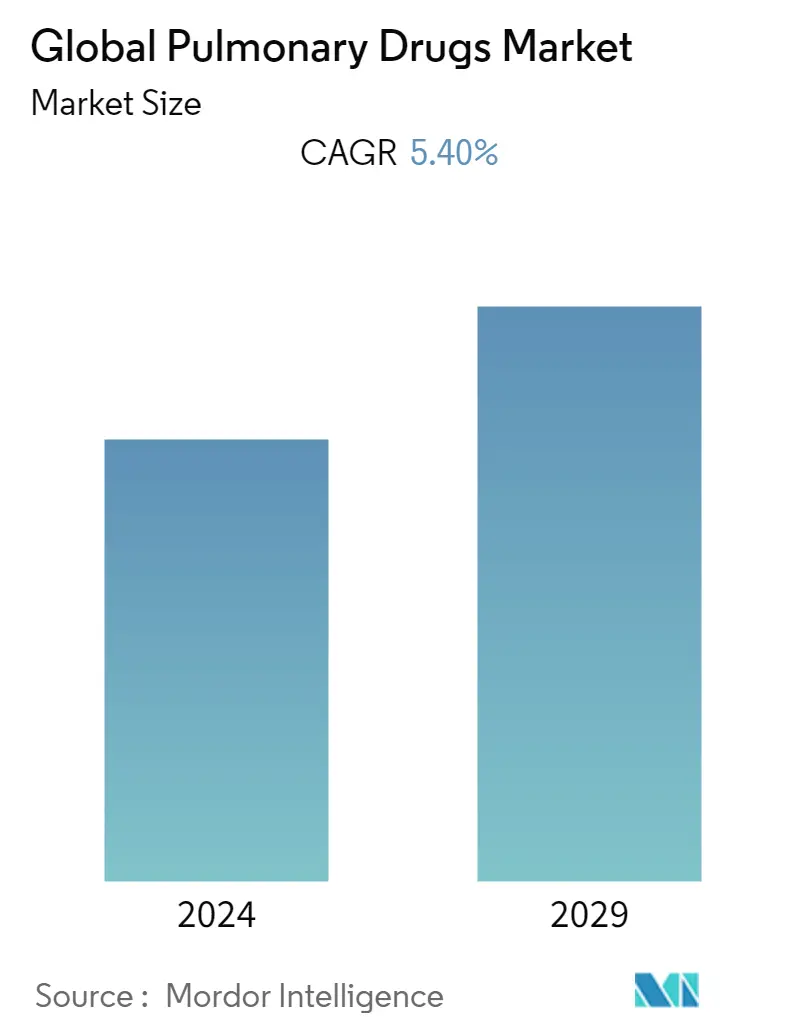
| Study Period | 2019 - 2029 |
| Base Year For Estimation | 2023 |
| CAGR | 5.40 % |
| Fastest Growing Market | Asia Pacific |
| Largest Market | North America |
| Market Concentration | Low |
Major Players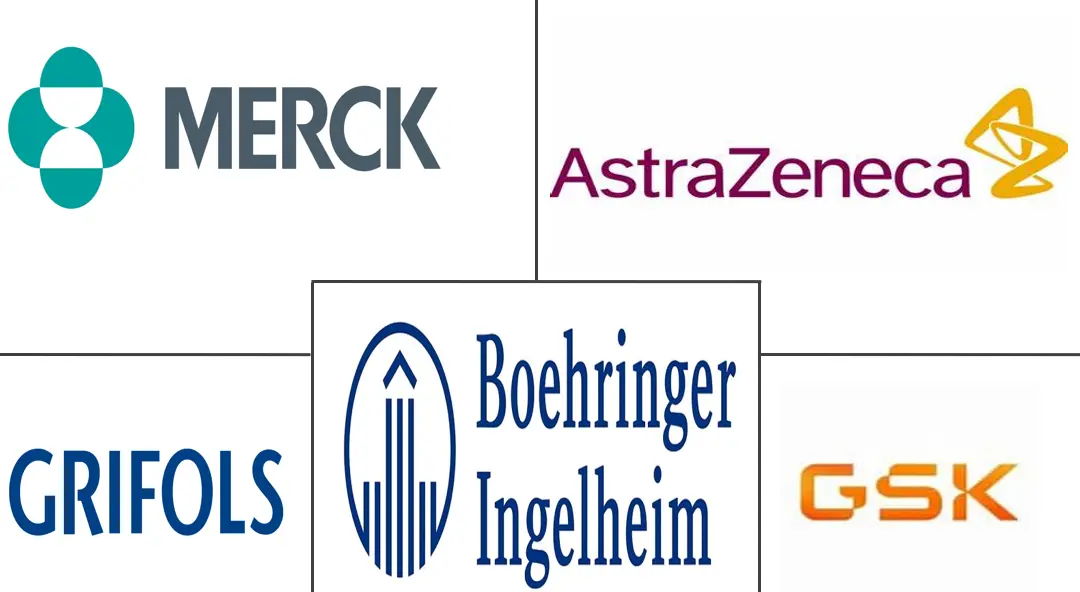
*Disclaimer: Major Players sorted in no particular order |
Pulmonary Drugs Market Analysis
The pulmonary drugs market is expected to register a CAGR of 5.4% over the forecast period (2022-2027).
The COVID-19 pandemic and lockdowns in various countries across the world have impacted the financial status of businesses across all sectors, including the private healthcare sector. The COVID-19 pandemic has impacted the entire supply chain of the healthcare industry, owing to the strict lockdown in several regions. Private healthcare is one such sector that has been impacted significantly by the COVID-19 pandemic.
However, the COVID-19 pandemic had a positive impact on the global pulmonary drugs market, due to patients with asthma and Chronic Obstructive Pulmonary Disease (COPD) being considered at increased risk of death from Covid-19. For instance, in August 2021, according to data published by National Center for Biotechnology Information, Asthma statistics worldwide for 2020 showed that more than 339 million individuals have asthma and that around four million children develop asthma each year on a global level. Thus, increasing cases of COVID-19 are rising the cases of respiratory disorders which generates the need for pulmonary drugs.
Additionally, various clinical research studies based on SARS-CoV-2 showcased that the virus is capable of changing pulmonary hemodynamics through the mechanisms of venous thromboembolism, endothelial dysfunction, thrombotic microangiopathy, and vascular leak. For instance, In January 2021, the National Center for Biotechnology Information (NCBI) published a study that states that those patients who died of COVID-19, exhibited thickened pulmonary vascular walls. This shows that in the future, SARS-CoV-2 can trigger the high susceptibility of infected individuals to developing pulmonary arterial hypertension. Thus, COVID-19 has a significant impact on market growth.
Certain factors that are driving the market growth include the rising prevalence of pulmonary diseases and the growing geriatric population. Pulmonary diseases affect the airways and other parts of the lungs for a long duration of the period. Respiratory symptoms are among the major causes of consultation with doctors and physicians in primary health care centers. Some of the major preventable chronic respiratory disorders are asthma, chronic obstructive pulmonary disease (COPD), allergic rhinitis, sleep apnea, and tuberculosis (principally, multi-drug resistant tuberculosis). As per the Asthma and allergy foundation of America published in March 2021, Roughly 1 in 13 Americans have asthma, which is about 25 million people. Asthma is one of the largest contributors to this figure, affecting children, adults, and elderly people. The same source stated that about 5 million American children have asthma. There is a high prevalence of severe asthma in the Middle East & Africa and the Latin America region as compared to the mid-range of prevalence in North America, Europe, and Asia-Pacific countries.
Another reason for the increased prevalence of respiratory diseases is the excessive environmental pollution in metropolitan cities and industrial lands. In addition, secondhand smoke exposure also leads to serious respiratory diseases. Stringent government regulations for product approval and side effects associated with drugs are hampering the growth of the market.
Pulmonary Drugs Market Trends
This section covers the major market trends shaping the Pulmonary Drugs Market according to our research experts:
Treatment for Chronic Obstructive Pulmonary Disease is Expected to Witness Growth Over the Forecast Period
Pulmonary drugs like bronchodilators are very common for Chronic Obstructive Pulmonary Disease treatment and symptoms. Bronchodilators are medications that usually come in inhalers. These medications relax the muscles around the patient's airways. This could help relieve coughing and shortness of breath and make breathing easier. Depending on the severity of the patient's disease, the patient may need a short-acting bronchodilator or a long-acting bronchodilator depending on the patient medical condition.
Chronic obstructive pulmonary disease (COPD) is a common, preventable, and treatable chronic lung disease that affects men and women worldwide. According to the World Health Organization (WHO) 2021 factsheet, COPD is the third-leading cause of death worldwide, causing 3.23 million deaths in 2020. Over 80% of these deaths occurred in low- and middle-income countries (LMIC). Moreover, the increasing geriatric population globally is boosting the market growth. According to the World Ageing 2020 report, in 2020, there were around 727 million people aged 65 years or more in the world. The number of older persons is projected to double to 1.5 billion in 2050. Globally, the share of the population aged 65 years or over increased from 9.3% in 2020 to reach 16% by 2050. Hence, owing to the fact that asthma is a widely prevalent disease found in people over the age of 65, the growing geriatric population is expected to drive the market growth over the forecast period.
In addition, technological advancements are anticipated to provide the market with lucrative opportunities. Limitations of traditional treatments, such as the late onset of action and low efficacy, are projected to encourage the development of novel targeted drugs, thereby boosting the market. For instance, in February 2021, Sanofi, in collaboration with Regeneron Pharmaceuticals, initiated a Phase III clinical trial to assess the efficacy and safety of itepekimab on the annualized rate of acute moderate-or-severe COPD exacerbations in former smokers with moderate-to-severe chronic obstructive pulmonary disease (COPD). The trial is expected to be completed in July 2024.
The market players are adopting various strategies such as product launches, developments, collaborations, acquisitions, and expansions to increase their market shares. For instance, in July 2020, Novartis AG received approval from the European Commission (EC) for Enerzair Breezhaler (indacaterol acetate, glycopyrronium bromide, and mometasone furoate [IND/GLY/MF]) as a maintenance treatment of asthma in adult patients not adequately controlled with a maintenance combination of a longacting beta2agonist (LABA) and a high-dose of an inhaled corticosteroid (ICS) who experienced one or more asthma exacerbations in the previous year. Thus, the aforementioned factors are boosting the growth of the market.
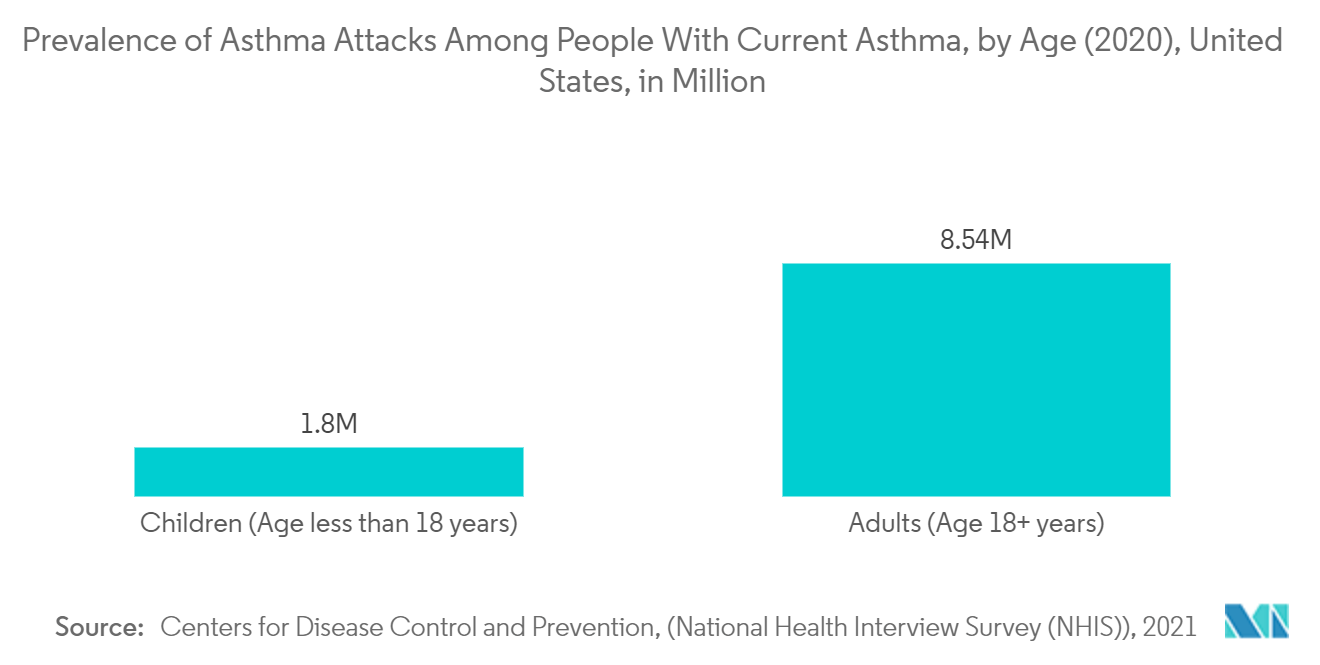
North America Dominates the Market and Expected to do Same in the Forecast Period
The increasing prevalence of respiratory diseases is the major factor expected to drive the overall growth of the market over the forecast period. Also, there is a rise in per capita health expenditure in the region, which is expected to increase over the forecast period, owing to the decrease in the unemployment rate. The cases of COPD are likely to increase in the United States, owing to the higher smoking prevalence and the aging population in the country.
In the United States, asthma is more common in adult women than in adult men. According to the Centers for Disease Control and Prevention 2021 report, in the United States, approximately 25 million Americans have asthma. This equals to about 1 in 13 Americans, including 8% of adults and 7% of children. About 20 million US adults aged 18 years and over have asthma.
Moreover, the rise in the number of initiatives undertaken by government and non-government organizations is increasing the overall revenue. For instance, CDC's National Asthma Control Program (NACP) provides funds for educating asthma-affected patients. Such initiatives are likely to increase awareness about asthma, which will increase the adoption of drugs in the treatment of asthma, leading to verticle growth.
In addition, the local presence of key pharmaceutical players, advanced healthcare infrastructure, and increasing research and development activities in the development of novel therapies are boosting the market growth. For instance, in March 2021, in Mexico and the United States, AstraZeneca PLC started a Phase III clinical trial to assess the efficacy and safety of budesonide/glycopyrronium/formoterol inhalers in adults and adolescents with severe asthma inadequately controlled with the standard of care. The trial is expected to be completed in September 2023. In July 2021, AstraZeneca's Biologics License Application (BLA) for tezepelumab was accepted and granted Priority Review for the treatment of asthma by the United States Food and Drug Administration (FDA). Tezepelumab is being developed by AstraZeneca in collaboration with Amgen Inc. Thus, the aforementioned factors are expected to drive the market growth over the forecast period.
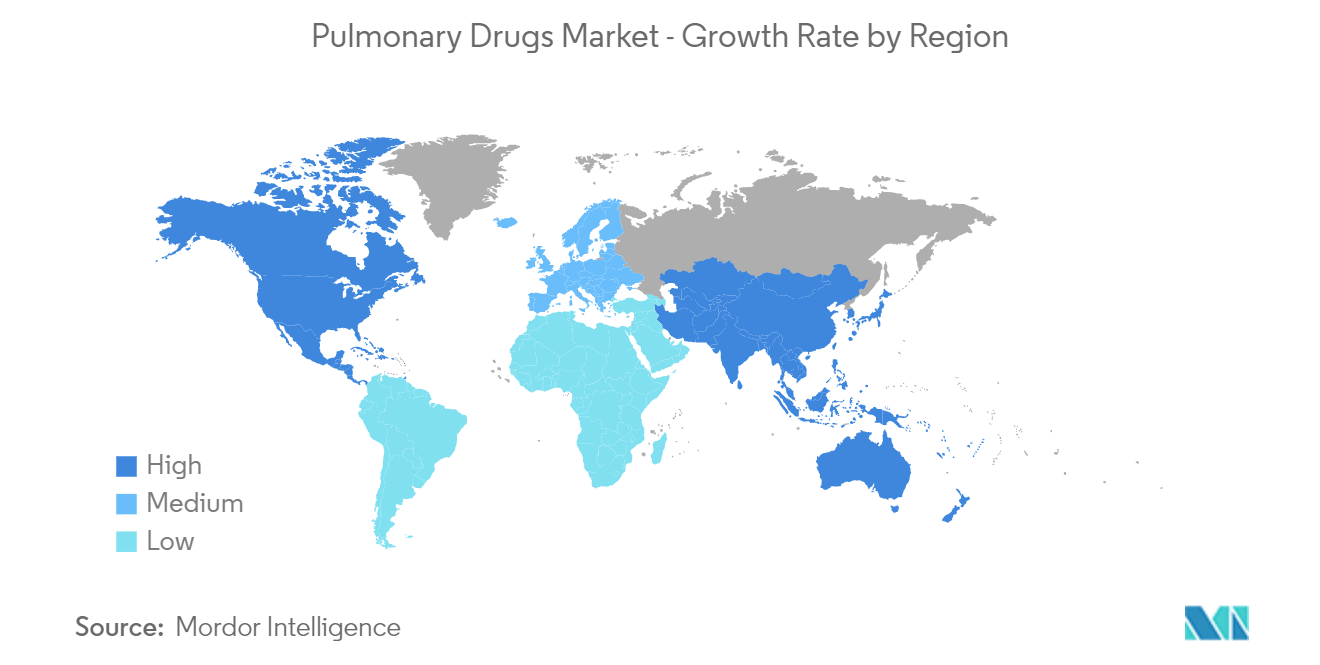
Pulmonary Drugs Industry Overview
The global pulmonary drugs market is highly competitive and consists of a number of major players. Companies like AstraZeneca, Boehringer Ingelheim, AstraZeneca PLC, Boehringer Ingelheim, F. Hoffmann-La Roche Ltd., GlaxoSmithKline PLC, Grifols, S.A., Merck & Co., Inc., Pfizer Inc., Regeneron Pharmaceuticals, Inc., Sumitomo Dainippon Pharma Co., Ltd., and Teva Pharmaceutical Industries Ltd. hold the substantial market share in the Pulmonary Drugs market.
Pulmonary Drugs Market Leaders
-
Boehringer Ingelheim
-
Merck & Co.
-
AstraZeneca PLC
-
GlaxoSmithKline PLC
-
Grifols, S.A.
*Disclaimer: Major Players sorted in no particular order
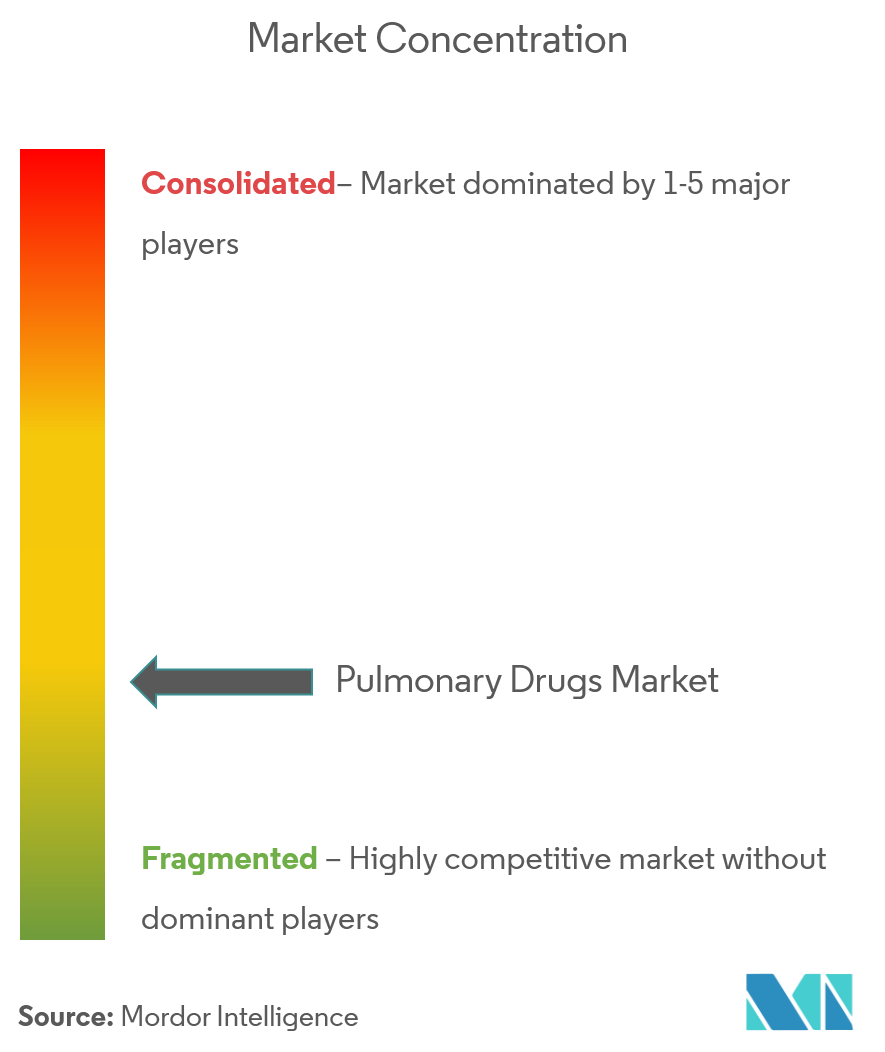
Pulmonary Drugs Market News
- In April 2022, Penn Medicine discovered a new type of cell that resides deep within human lungs and may play a key role in human lung diseases. The researchers, analyzed human lung tissue to identify the new cells, which they called respiratory airway secretory cells (RASCs). The cells line tiny airway branches, deep in the lungs, near the alveoli structures where oxygen is exchanged for carbon dioxide. The scientists showed that Renal Allograft Compartment Syndrome (RASCs) have stem-cell-like properties enabling them to regenerate other cells that are essential for the normal functioning of alveoli. They also found evidence that cigarette smoking and the common smoking-related ailment called chronic obstructive pulmonary disease (COPD) can disrupt the regenerative functions of Renal Allograft Compartment Syndrome (RASCs)-hinting that correcting this disruption could be a good way to treat COPD.
- In December 2021, AstraZeneca included a novel target for idiopathic pulmonary fibrosis (IPF) in its medication development portfolio, detected utilizing BenevolentAI's platform. This is notedly the second novel target from the collaboration that has been recognized, approved, and chosen for AstraZeneca's portfolio. BenevolentAI's collaboration with AstraZeneca presently targets the detection of possible novel treatments for IPF and chronic kidney disease (CKD).
Pulmonary Drugs Market Report - Table of Contents
1. INTRODUCTION
- 1.1 Study Assumptions and Market Definition
- 1.2 Scope of the Study
2. RESEARCH METHODOLOGY
3. EXECUTIVE SUMMARY
4. MARKET DYNAMICS
- 4.1 Market Overview
-
4.2 Market Drivers
- 4.2.1 Rising Prevalence of Pulmonary Diseases
- 4.2.2 Increasing Burden of Geriatric Population
-
4.3 Market Restraints
- 4.3.1 Stringent Government Regulations for Product Approval
- 4.3.2 Side Effects Associated With Drugs
-
4.4 Porter's Five Force Analysis
- 4.4.1 Threat of New Entrants
- 4.4.2 Bargaining Power of Buyers/Consumers
- 4.4.3 Bargaining Power of Suppliers
- 4.4.4 Threat of Substitute Products
- 4.4.5 Intensity of Competitive Rivalry
5. MARKET SEGMENTATION (Market Size by Value - USD million)
-
5.1 By Drug Class
- 5.1.1 Beta-2 Agonists
- 5.1.2 Anti-cholinergic Agents
- 5.1.3 Oral and Inhaled Corticosteroids
- 5.1.4 Anti-leukotrienes
- 5.1.5 Antihistamines
- 5.1.6 Monoclonal Antibodies
- 5.1.7 Combination Drugs
- 5.1.8 Others
-
5.2 By Indication
- 5.2.1 Asthma
- 5.2.2 COPD (Chronic Obstructive Pulmonary Disease)
- 5.2.3 Allergic Rhinitis
- 5.2.4 Pulmonary Arterial Hypertension
- 5.2.5 Cystic Fibrosis
- 5.2.6 Others
-
5.3 By Distribution Channel
- 5.3.1 Hospital Pharmacies
- 5.3.2 Retail Pharmacies
- 5.3.3 Others
-
5.4 Geography
- 5.4.1 North America
- 5.4.1.1 United States
- 5.4.1.2 Canada
- 5.4.1.3 Mexico
- 5.4.2 Europe
- 5.4.2.1 Germany
- 5.4.2.2 United Kingdom
- 5.4.2.3 France
- 5.4.2.4 Italy
- 5.4.2.5 Spain
- 5.4.2.6 Rest of Europe
- 5.4.3 Asia Pacific
- 5.4.3.1 China
- 5.4.3.2 Japan
- 5.4.3.3 India
- 5.4.3.4 Australia
- 5.4.3.5 South Korea
- 5.4.3.6 Rest of Asia-Pacific
- 5.4.4 Middle East and Africa
- 5.4.4.1 GCC
- 5.4.4.2 South Africa
- 5.4.4.3 Rest of Middle East and Africa
- 5.4.5 South America
- 5.4.5.1 Brazil
- 5.4.5.2 Argentina
- 5.4.5.3 Rest of South America
6. COMPETITIVE LANDSCAPE
-
6.1 Company Profiles
- 6.1.1 AstraZeneca PLC
- 6.1.2 Boehringer Ingelheim
- 6.1.3 Circassia Pharmaceuticals Plc
- 6.1.4 F. Hoffmann-La Roche Ltd.
- 6.1.5 GlaxoSmithKline PLC
- 6.1.6 Grifols, S.A.
- 6.1.7 Merck & Co., Inc.
- 6.1.8 Pfizer Inc.
- 6.1.9 Regeneron Pharmaceuticals, Inc.
- 6.1.10 Sanofi SA
- 6.1.11 Sumitomo Dainippon Pharma Co., Ltd.
- 6.1.12 Teva Pharmaceutical Industries Ltd.,
- *List Not Exhaustive
7. MARKET OPPORTUNITIES AND FUTURE TRENDS
** Subject To AvailablityPulmonary Drugs Industry Segmentation
As per the scope of the report, pulmonary diseases refer to the types of diseases that affect the lungs and other parts of the respiratory system. Pulmonary diseases may be caused by infection, by smoking tobacco, or by breathing in secondhand tobacco smoke, radon, asbestos, or other forms of air pollution. Pulmonary drugs are the branch of medicine that deals with the causes, diagnosis, prevention, and treatment of such pulmonary diseases. The Pulmonary Drugs Market is segmented by Drug Class (Beta-2 Agonists, Anticholinergic Agents, Oral and Inhaled Corticosteroids, Anti-leukotrienes, Antihistamines, Monoclonal Antibodies, Combination Drugs, and others), Indication (Asthma, COPD (Chronic Obstructive Pulmonary Disease), Allergic Rhinitis, Pulmonary Arterial Hypertension, Cystic Fibrosis, and Others), Distribution Channel (Hospital Pharmacies, Retail Pharmacies, and others), and Geography (North America, Europe, Asia-Pacific, Middle East and Africa, and South America). The market report also covers the estimated market sizes and trends for 17 different countries across major regions, globally. The report offers the value (in USD million) for the above segments.
| By Drug Class | Beta-2 Agonists | |
| Anti-cholinergic Agents | ||
| Oral and Inhaled Corticosteroids | ||
| Anti-leukotrienes | ||
| Antihistamines | ||
| Monoclonal Antibodies | ||
| Combination Drugs | ||
| Others | ||
| By Indication | Asthma | |
| COPD (Chronic Obstructive Pulmonary Disease) | ||
| Allergic Rhinitis | ||
| Pulmonary Arterial Hypertension | ||
| Cystic Fibrosis | ||
| Others | ||
| By Distribution Channel | Hospital Pharmacies | |
| Retail Pharmacies | ||
| Others | ||
| Geography | North America | United States |
| Canada | ||
| Mexico | ||
| Geography | Europe | Germany |
| United Kingdom | ||
| France | ||
| Italy | ||
| Spain | ||
| Rest of Europe | ||
| Geography | Asia Pacific | China |
| Japan | ||
| India | ||
| Australia | ||
| South Korea | ||
| Rest of Asia-Pacific | ||
| Geography | Middle East and Africa | GCC |
| South Africa | ||
| Rest of Middle East and Africa | ||
| Geography | South America | Brazil |
| Argentina | ||
| Rest of South America |
Pulmonary Drugs Market Research FAQs
What is the current Global Pulmonary Drugs Market size?
The Global Pulmonary Drugs Market is projected to register a CAGR of 5.40% during the forecast period (2024-2029)
Who are the key players in Global Pulmonary Drugs Market?
Boehringer Ingelheim, Merck & Co., AstraZeneca PLC, GlaxoSmithKline PLC and Grifols, S.A. are the major companies operating in the Global Pulmonary Drugs Market.
Which is the fastest growing region in Global Pulmonary Drugs Market?
Asia Pacific is estimated to grow at the highest CAGR over the forecast period (2024-2029).
Which region has the biggest share in Global Pulmonary Drugs Market?
In 2024, the North America accounts for the largest market share in Global Pulmonary Drugs Market.
What years does this Global Pulmonary Drugs Market cover?
The report covers the Global Pulmonary Drugs Market historical market size for years: 2019, 2020, 2021, 2022 and 2023. The report also forecasts the Global Pulmonary Drugs Market size for years: 2024, 2025, 2026, 2027, 2028 and 2029.
Breathing Disorders Treatment Industry Report
Statistics for the 2024 Breathing Disorders Treatment market share, size and revenue growth rate, created by Mordor Intelligence™ Industry Reports. Breathing Disorders Treatment analysis includes a market forecast outlook 2029 and historical overview. Get a sample of this industry analysis as a free report PDF download.



